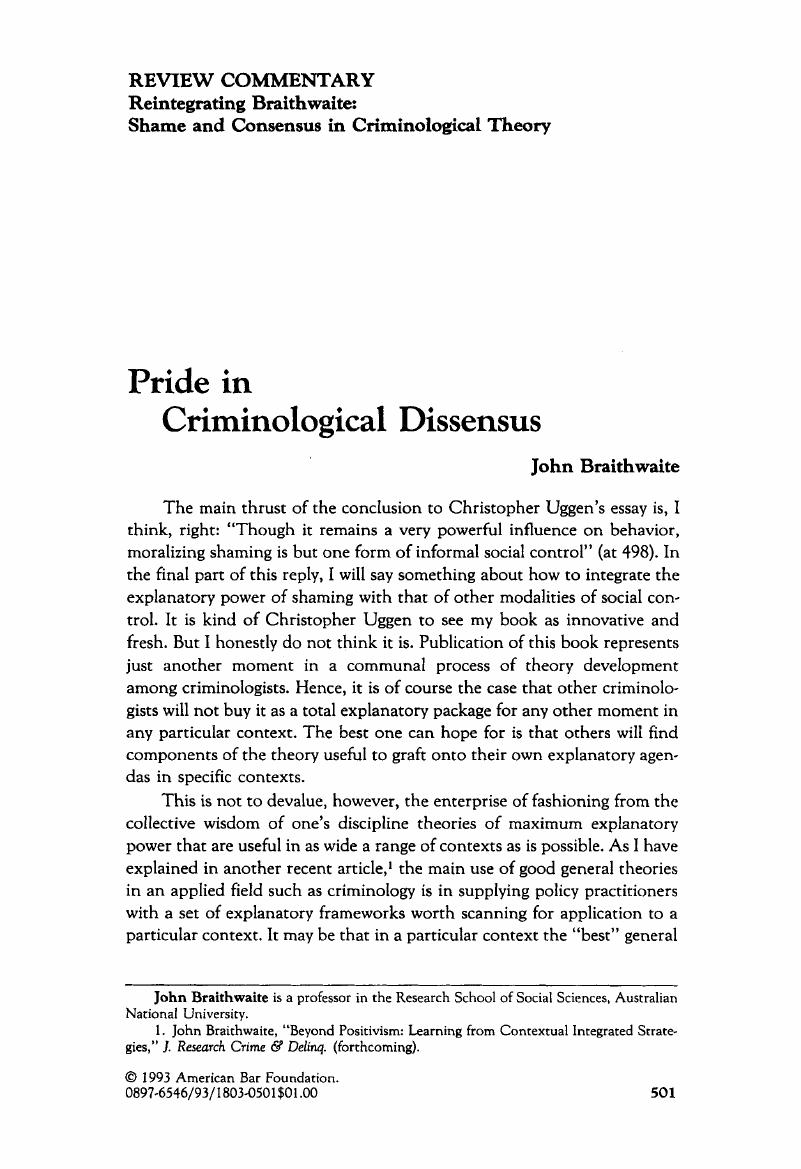Published online by Cambridge University Press: 27 December 2018

1 John Braithwaite, “Beyond Positivism: Learning from Contextual Integrated Strategies,”J. Research Crime & Delinq. (forthcoming).Google Scholar
2 Elliott Currie, Conboonring Crime: An American Challenge 46 (New York: Pantheon, 1985).Google Scholar
3 See John Braithwaite, Bruce Chapman, & Cezary A. Kapuscinski, “Unemployment and Crime: Resolving the Paradox,” American Bar Foundation Working Paper No. 9201 (Chicago: American Bar Foundation, 1992).Google Scholar
4 John Braithwaite, Inequality, Crime and Public Policy (London: Routledge & Kegan Paul, 1979).Google Scholar
5 Braithwaite, John, “Poverty, Power, White-collar Crime and the Paradoxes of Criminological Theory,” 24 Australian & New Zealand J. Criminology 40 (1991).CrossRefGoogle Scholar
6 Sykes, Gresham & Matza, David, “Techniques of Neutralization: A Theory of Delinquency,” 22 Am Soc. Rev. 664 (1957).CrossRefGoogle Scholar
7 Erving Goffman, Relations in Public (New York: Basic Books, 1971).Google Scholar
8 See, e.g., Robert J. Sampson, “Communities and Crime,” in M. Gotcfredson & T. Hirschi, eds., Positive Criminology (Beverly Hills, Cal.: Sage Publications, 1987) (“Sampson, ‘Communities and Crime’”).Google Scholar
9 Tilly, Charles, “Do Communities Act 43 Soc. Inquiry 206 (1973).CrossRefGoogle Scholar
10 Granovetter, Mark, “The Strength of Weak Ties,” 78 Am. J. Soc. 1360 (1973).CrossRefGoogle Scholar
11 Sampson, “Communities and Crime,” at 110.Google Scholar
12 Shearing, Clifford D. & Ericson, Richard, “Police Culture: Towards a Figurative Conception of Action,” 42 Brit. J. Soc. 481 (1991), citing Lyotard and Barthes.CrossRefGoogle Scholar
13 Clifford Shearing, personal communication, 1992.Google Scholar
14 Toni Makkai & John Braithwaite, “Reintegrative Shaming and Compliance with Regulatory Standards” (unpublished, Australian National University).Google Scholar
15 At least never for those rights which the republican theory says should be rights. See John Braithwaite & Philip Pettit, Not Just Deserts: A Republican Theory of Criminal Justice (Oxford: Clarendon Press, 1990).Google Scholar
16 Id. Google Scholar
17 See David B. Moore, “Evaluating Family Group Conferences: Some Early Findings from Wagga Wagga,” Criminal Justice Planning & Coordination Conference (Canberra: Australian Institute of Criminology, 1993).Google Scholar
18 John Braithwaite, Crime, Shame and Reintegration 142 (Cambridge: Cambridge University Press, 1989).CrossRefGoogle Scholar
19 See John Braithwaite, “Inequality and Republican Criminology,”in J. Hagan &. R. Peterson, eds., Crime and Inequality (Stanford, Cal.: Stanford University Press, 1993).Google Scholar
20 James S. Coleman, “The Rational Reconstruction of Society,” 58 Am. Soc. Rev. 1 (1993); id., Foundation of Social Theory (Cambridge, Mass.: Harvard University Press, Belknap Press, 1990).Google Scholar
21 See Goodin, Robert E., “Making Moral Incentives Pay,” 12 Pol'y Sci. 131 (1980).CrossRefGoogle Scholar
22 See the studies cited in Ian Ayres & John Braithwaite, Responsive Regulation: Transcending the Deregulation Debate 49–51 (New York: Oxford University Press, 1992).Google Scholar
23 Id., ch. 2.Google Scholar